
Calathea : varieties, growing and care
Contents
The Calathea in a few words
- This is an indoor green plant with exceptional graphic and colourful foliage
- It offers numerous varieties to suit all tastes and interiors
- Its leaves have the unique characteristic of folding at night and unfolding during the day
- It is easy to cultivate, provided its needs for humidity and indirect light are met
- It purifies the surrounding air by absorbing certain harmful substances like formaldehyde
The word from our expert
Native to the tropical forests of Central and South America, the Calathea or “peacock plant” is an easy-to-grow tropical houseplant, much like the popular Calathea orbifolia – A unique striped indoor plant, notable for its large, round, and broad leaves adorned with elegant silver stripes, or the Calathea ornata with its pink veins. The Calathea never ceases to amaze! Its countless varieties enchant our interiors with their lush, colourful leaves, decorated with unique patterns that seem hand-painted. Sometimes nicknamed the “prayer plant” due to the graceful movements of its leaves, which open and fold according to the light, it fascinates with its lively character.
Capable of purifying the air while adding a jungle touch, it fits perfectly into our homes, provided its needs for indirect light, humidity, and attentive care are met. It is essential to keep the Calathea at a temperature above 15°C at all times and to ensure its foliage is misted, especially in summer and winter when heating dries out the surrounding air.
Let yourself be seduced by the natural elegance and exotic charm of the Calathea—each variety is unique!
Discover also our complete guide on growing and caring for Calathea
botany
Botanical data
- Latin name Calathea
- Family Marantaceae
- Common name Calathea, Peacock plant, Zebra plant
- Flowering rare indoors
- Height Between 30 cm and 1 m
- Sun exposure Bright
- Soil type Rich, well-drained, slightly acidic substrate
- Hardiness Frost-sensitive
The Calathea belongs to the Marantaceae botanical family, just like the Maranta (prayer plant). This genus includes more than 275 species in the wild, with around 25 to 30 varieties commonly cultivated as houseplants, each distinguished by unique leaf patterns, colours, and shapes.
Among the most frequently cultivated indoor species, you’ll find classics like the Calathea makoyana, also known as the “peacock plant,” which features broad leaves with patterns resembling bird feathers, the Calathea orbifolia, prized for its large, round leaves adorned with silver stripes, the Calathea ornata, with its pink-striped leaves resembling brushstrokes, or the Calathea lancifolia (rattlesnake plant), recognisable by its long, undulating leaves with spotted patterns. Other notable species include:
- Calathea roseopicta: Known for its round leaves with colourful patterns, often featuring shades of pink, it has spawned many cultivars, such as Calathea ‘Medallion’, Calathea ‘Dottie’, ‘Flamestar’, ‘Rosy‘, ‘Triostar’, and ‘Surprisestar’.
- Calathea zebrina: Nicknamed the “zebra plant,” it displays lance-shaped leaves with stripes reminiscent of a zebra’s.
- Calathea crocata: Also called the “saffron-coloured calathea,” it is cherished for its bright orange flowers, rare among Calatheas, which bloom in summer.
- Calathea insignis : Resembling the Calathea makoyana, it stands out with longer, narrower, and undulating leaves, featuring a striking purple underside visible due to its upright habit. It offers a tricolour display.
- Calathea warscewiczii : With its long, upright, and light-green-veined leaves, it exudes an airy appearance. Under ideal conditions, it may flower, producing ivory then pink cones.
- Calathea leopardina : Featuring long, narrow, cream-coloured leaves marked by highly graphic green patterns reminiscent of wallpaper.
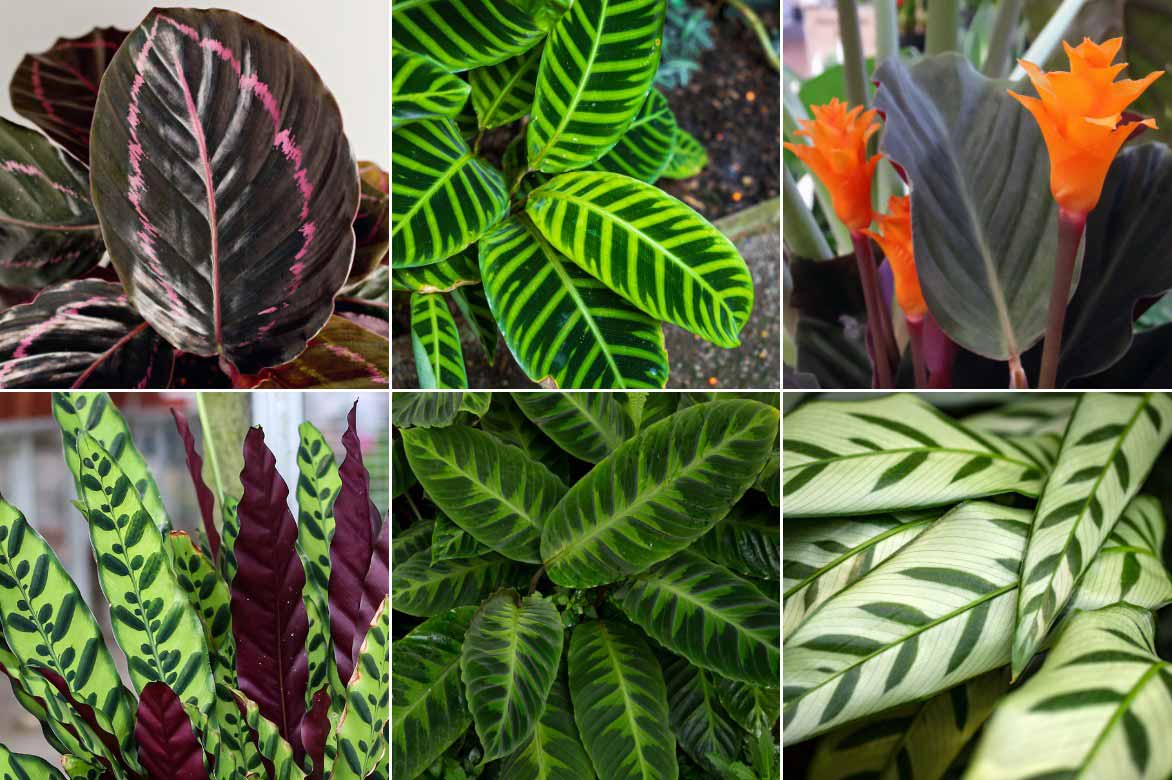
Calatheas encompass numerous species primarily distinguished by their foliage. Calathea roseopicta, Calathea zebrina, Calathea crocata with majestic orange flowers,Calathea insignis, Calathea warscewiczii and Calathea leopardina
Native to the tropical undergrowth of Central and South America, all thrive in warm, humid, and shaded environments, mimicking the conditions of tropical forests where they naturally grow. The Calathea thrives in rich, well-drained soil, where ambient humidity plays a crucial role.
The Calathea stands out for its elegant and bushy habit, giving it a dense yet harmonious appearance. This herbaceous plant grows relatively slowly in dense clumps, with leaves emerging directly from the base and renewing regularly. In pots, it typically measures between 30 and 80 cm in height, rarely exceeding 1 m to 1.30 m in its natural habitat.
The Calathea has a rhizomatous root system that allows it to spread in the soil. This system is relatively shallow, making it suitable for wide rather than deep pots.
The evergreen foliage is the most remarkable characteristic of Calatheas. The leaves vary by species in their colours, patterns (marbled, spotted, or striped) and textures. They often display complex designs with shades of green, white, pink, purple, or silver. Calathea leaves average between 15 and 45 cm in length and about 10 to 20 cm in width, though some species like the Calathea orbifolia can produce more imposing leaves, reaching up to 50 cm in length.
The leaves are oval or elliptical in shape, sometimes slightly elongated or pointed, with a smooth texture and a generally satiny surface that subtly reflects light. The veins are well-defined, highlighting the intricate patterns, and their edges are occasionally undulate, as seen in the Calathea lancifolia. Their undersides are purple or burgundy. These leaves have the unique ability to move: they rise or fold in response to light, a movement called nyctinasty. This natural leaf movement, where they open when the room brightens or curl up like cigars in darkness, is not only aesthetic but also functional. The plant optimises its exposure to light during the day and reduces moisture loss at night. This behaviour has earned it the nickname “prayer plant,” as the leaves appear to join together like hands in meditation.
Although Calatheas are primarily grown for their foliage, they can produce flowers. These inflorescences, often discreet, are borne on short stems and usually take the form of small spikes or clusters of tubular flowers nestled beneath the leaves. They are white, cream, or sometimes pink, but their flowering indoors remains rare. In the wild, it is more frequent due to ideal heat and humidity conditions.
The Calathea is often considered an air-purifying houseplant. Like many tropical plants, it helps purify the air by absorbing harmful substances such as formaldehyde, benzene, or toluene, commonly found in furniture, paints, or cleaning products.

The Calathea makoyana, also known as the Peacock plant, is likely the most well-known and widely cultivated species
Main species and varieties of peacock plants
How to plant a Calathea?
Where to Place a Calathea?
The Calathea thrives best in a bright room, but away from direct sunlight, as its delicate leaves may burn or fade under intense light. A spot near a north-facing window or filtered by sheer curtains, yet well-lit, is ideal. Since humidity is crucial, it’s wise to place it in a bright bathroom or near a humidifier. A heated greenhouse or conservatory also works well to mimic its natural conditions. Avoid drafts and temperature fluctuations, as the plant prefers stable, warm conditions. The Calathea retains its beauty when kept at consistent temperatures around 20°C year-round. Therefore, it’s important to protect it from cold, especially in early autumn and late spring, to ensure its flourishing indoors. Keep the plant in a room where temperatures stay between 18 and 25°C, without sudden changes or drafts. It dislikes the cold, and temperatures below 15°C can be fatal.
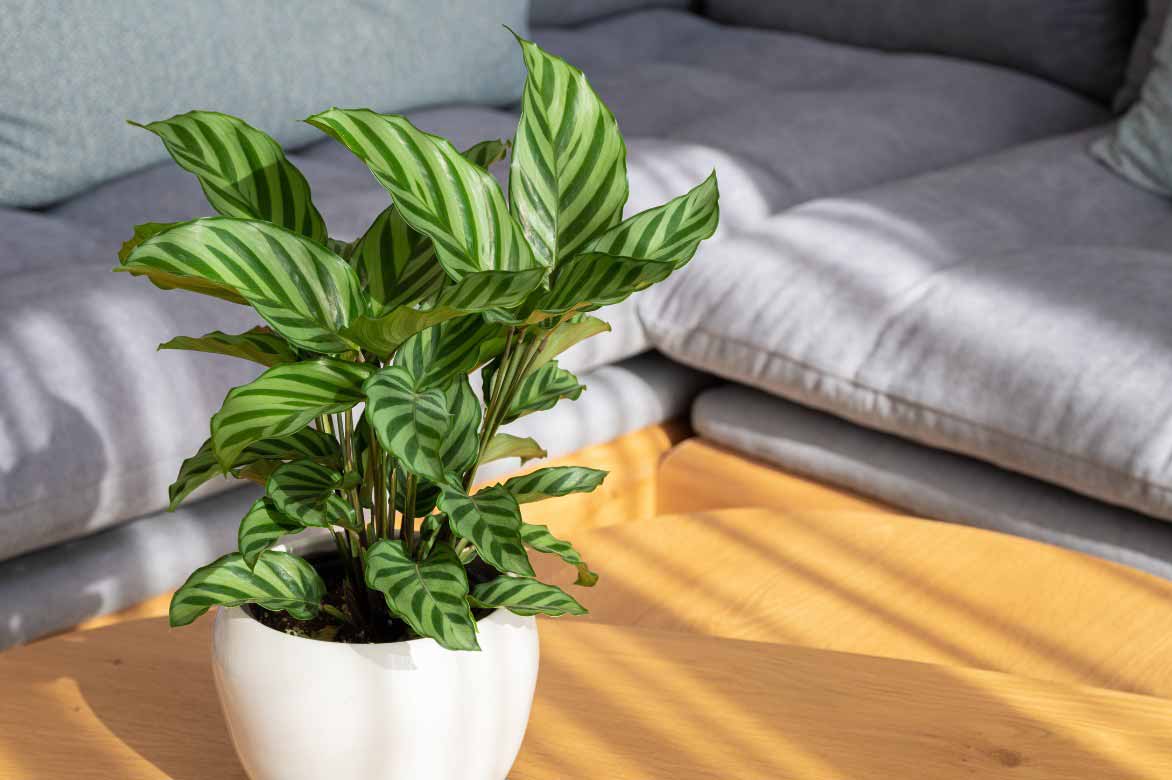
The Calathea prefers a bright but filtered location (for example, behind a window with sheer curtains), as direct sunlight could scorch its leaves
When to Plant?
A Calathea can be planted throughout the year, provided it’s given suitable conditions. Since homes offer a controlled environment with generally stable temperatures and no frost, there’s no restriction on when to introduce this plant.
How to Plant Calathea?
- Choose a pot about 13–18 cm in diameter and equally deep, slightly larger than the plant’s root ball, with drainage holes to prevent waterlogging.
- Add a layer of clay pebbles at the bottom to limit stagnation.
- Plant in a slightly acidic substrate made of one-quarter heather soil, a good houseplant compost, and some coarse sand.
- Gently remove the plant from its original pot. If the roots are tangled or tight, loosen them slightly with your fingers to encourage growth.
- Place the root ball in the centre of the new pot and adjust the height so the top of the root ball sits just below the pot’s rim.
- Fill the gaps around the root ball with the prepared compost, lightly firming it to stabilise the plant without compacting too much.
- Water thoroughly after planting to moisten the substrate and help the plant settle. Let excess water drain and maintain consistent moisture afterward, without waterlogging the soil.
- Place the Calathea in a bright spot, away from direct sunlight and drafts, while ensuring high ambient humidity.
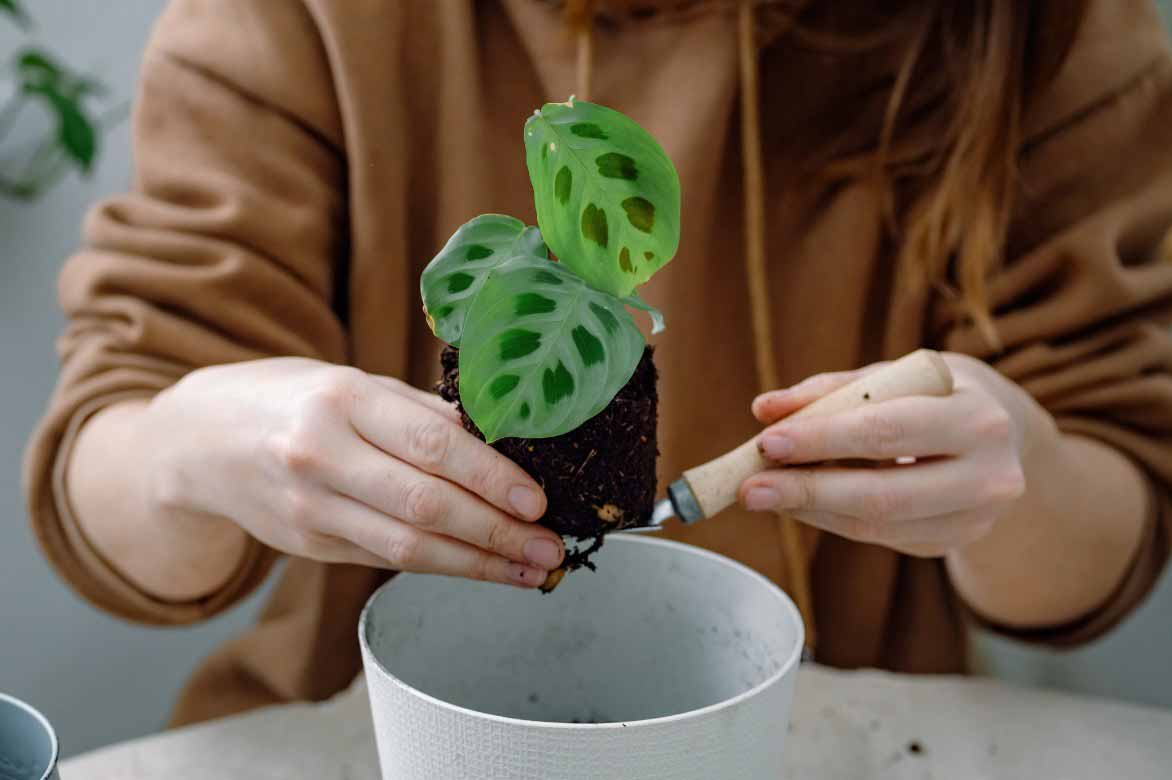
Repot the Calathea in a suitably sized pot, slightly larger than the root ball
How to care for the Calathea?
The care of the Calathea requires special attention to replicate its natural conditions and ensure its flourishing.
Keep the substrate slightly moist, but not waterlogged. Water as soon as the surface of the compost begins to dry, using non-calcareous water (such as rainwater or filtered water) at room temperature. Avoid overwatering to prevent root rot:
- In summer: water every 2 to 3 days.
- In winter: watering once every two weeks is usually sufficient.
The Calathea thrives in a humid atmosphere, similar to that of tropical forests. Place a humidifier near the plant, regularly mist its leaves with soft water, or set the pot on a tray filled with wet clay pebbles to increase ambient humidity.
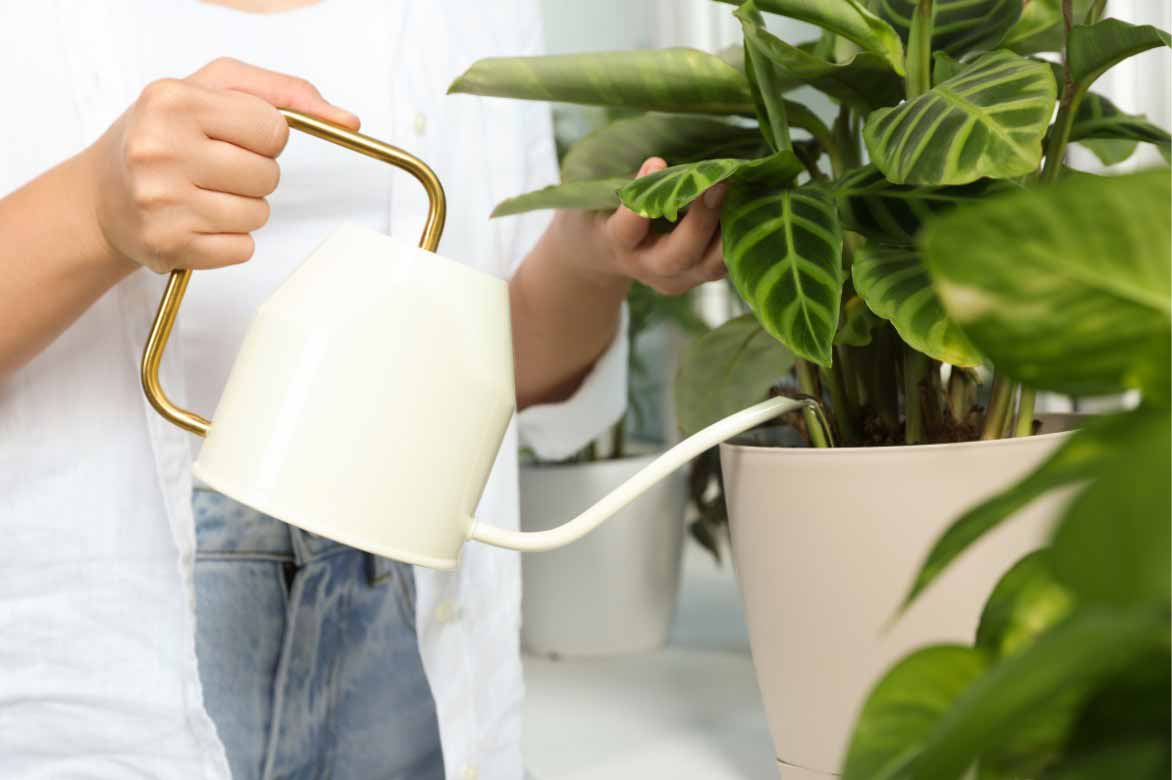
Remember to water your Calathea regularly to keep the substrate slightly moist
The Calathea does not require specific pruning. Simply remove damaged or yellowing leaves regularly to promote the overall health of the plant and maintain its tidy appearance.
During the growth period, from spring to autumn, fertilise once a month with a liquid fertiliser for houseplants, diluted by half to avoid excess mineral salts. In winter, reduce or stop fertilising.
Wipe the leaves regularly with a damp cloth to remove dust and allow the plant to breathe and absorb light more efficiently.
We recommend repotting your Calathea every year or every two years into a slightly larger pot to refresh the substrate and preserve its vitality.
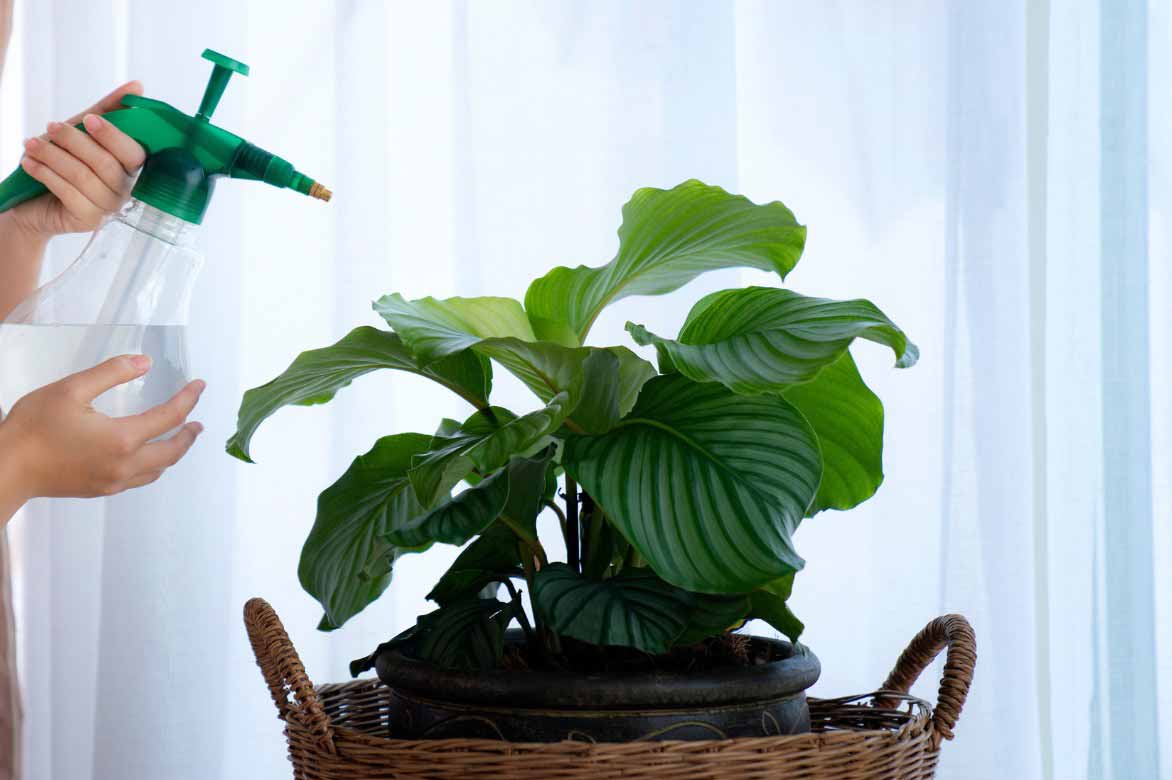
The Calathea will appreciate it if you mist its foliage occasionally
Diseases and Pests of Calathea
Calathea can be susceptible to a few diseases and pests when grown indoors, especially if conditions are not ideal. Among the common issues are spider mite infestations, which are particularly frequent when the air is too dry. These tiny mites cause the leaves to yellow, and fine webs may appear on their surface. To naturally combat spider mites on a Calathea, it is essential to increase the humidity around the plant, as these mites thrive in dry environments. A simple solution is to regularly mist the leaves with soft water to deter them. In case of an infestation, you can also prepare a natural mixture using black soap: dilute one tablespoon of black soap in one litre of lukewarm water, then spray this mixture on and under the leaves, where spider mites hide. To enhance its effectiveness, add a few drops of neem essential oil to the mixture, known for its insecticidal properties. Also, ensure you clean the leaves thoroughly with a damp cloth and increase ambient humidity using a humidifier or a tray of wet clay pebbles. This will make the environment less favourable for their return.
Scale insects, appearing as small white or brown bumps, can also settle on the leaves and stems, weakening the plant. They can be removed manually using a cotton swab dipped in 70°C alcohol.
→ Read our articles to learn more about suitable treatments: scale insects, spider mites.
Why do the leaf edges turn brown?
Excess moisture in the substrate or poor drainage can lead to root rot or fungal infections, causing brown or black spots on the leaves. Calatheas may develop brown leaf edges when the air is too dry or watering is inadequate. They require high ambient humidity, which is why it’s important to mist the foliage regularly and keep the substrate slightly moist without overwatering. Overwatering and poor drainage can also cause these stress signs. Additionally, avoid over-fertilising, as this can cause leaf edge burns.
Botrytis, a grey mould, can also appear if the ambient air is too humid and poorly ventilated. Finally, inadequate lighting or watering can lead to symptoms such as browning, curling, or drying leaf edges.
Prevention remains the best solution: monitor humidity levels and ensure proper room ventilation.
→ To learn more, read our article: “Calathea: Diseases, Common Problems, and Parasites“.
How to propagate a Calathea?
Calatheas cannot be propagated from cuttings, but you can divide the clumps in spring or early summer, when the plant is in full growth and better able to recover after division.
- Water the plant thoroughly the day before to make it easier to remove the root ball and avoid stressing the roots.
- Carefully remove the Calathea from its pot to access its rootstocks and clumps. Be careful not to damage the roots.
- Using your hands or a clean, disinfected knife, divide the root ball into several sections, each with at least a few leaves and a good root network.
- Plant each section in a new pot filled with a light, well-draining potting mix suitable for tropical plants. Ensure the collar (the base of the stems) remains just at soil level.
- Water the new plants lightly after planting to settle the soil around the roots.
- Place them in a bright spot, away from direct sunlight, and maintain high humidity to encourage recovery.
- For the first few weeks, keep the substrate slightly moist and ensure the plant does not experience sudden changes in light or temperature.
The green touch indoors with the calathea
The Calathea is a versatile plant that adds an exotic and refined touch to any interior. With its graphic and colourful foliage, it brightens up a living room, bedroom, or even a well-lit bathroom. Place it in a stylish ceramic or wicker pot, or in a natural-toned planter to highlight its tropical appeal.
On a side table, console, or even on the floor in a large pot, it pairs perfectly with modern, bohemian, or Scandinavian styles. Combine it with other plants featuring more subdued foliage to showcase its patterns, or group several varieties together to create a jungle corner with tropical plants like Monsteras or Philodendrons.
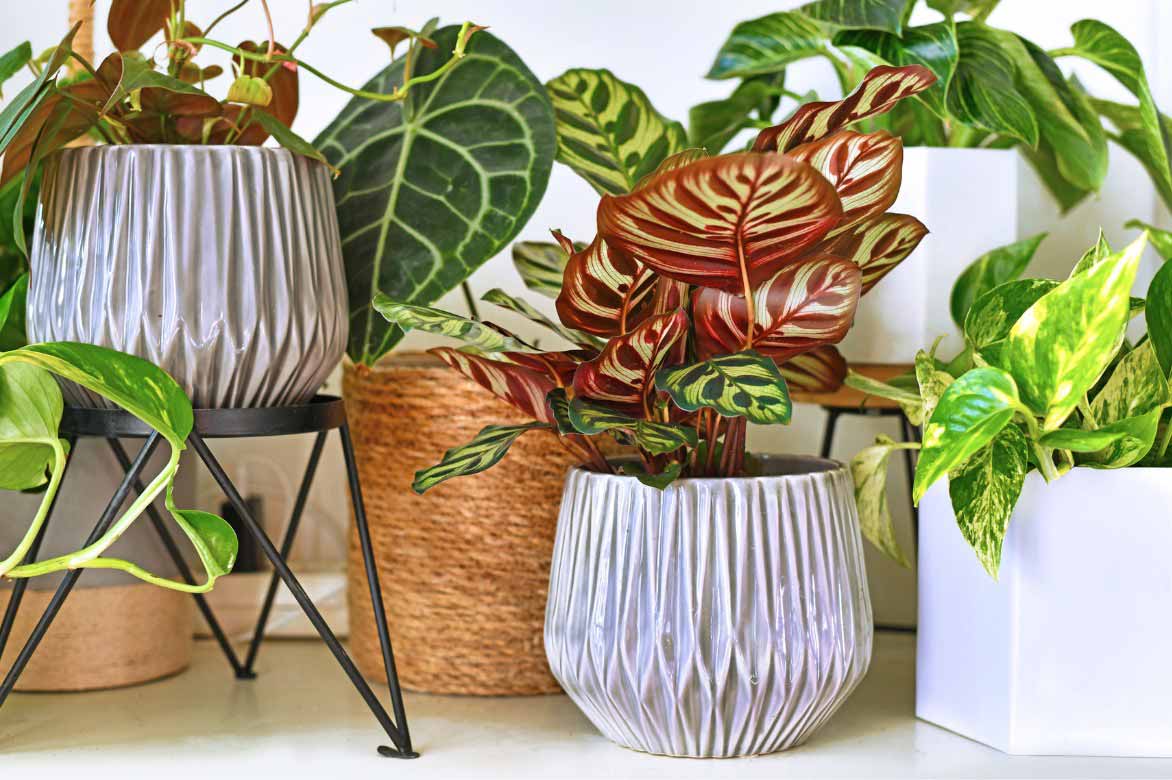
For a stunning effect, place the Calathea in a stylish planter alongside other decorative indoor plants
Useful resources
- Discover our range of houseplants and flowering indoor plants to bring exoticism and elegance to your home.
- Subscribe!
- Contents
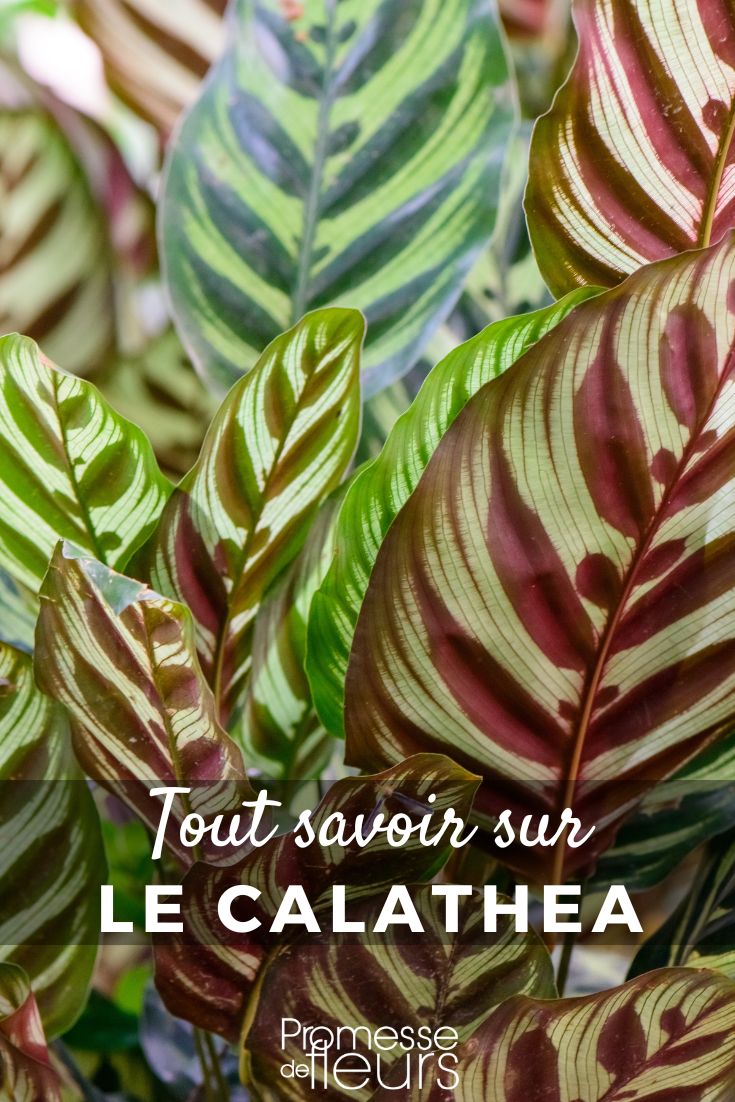































Comments